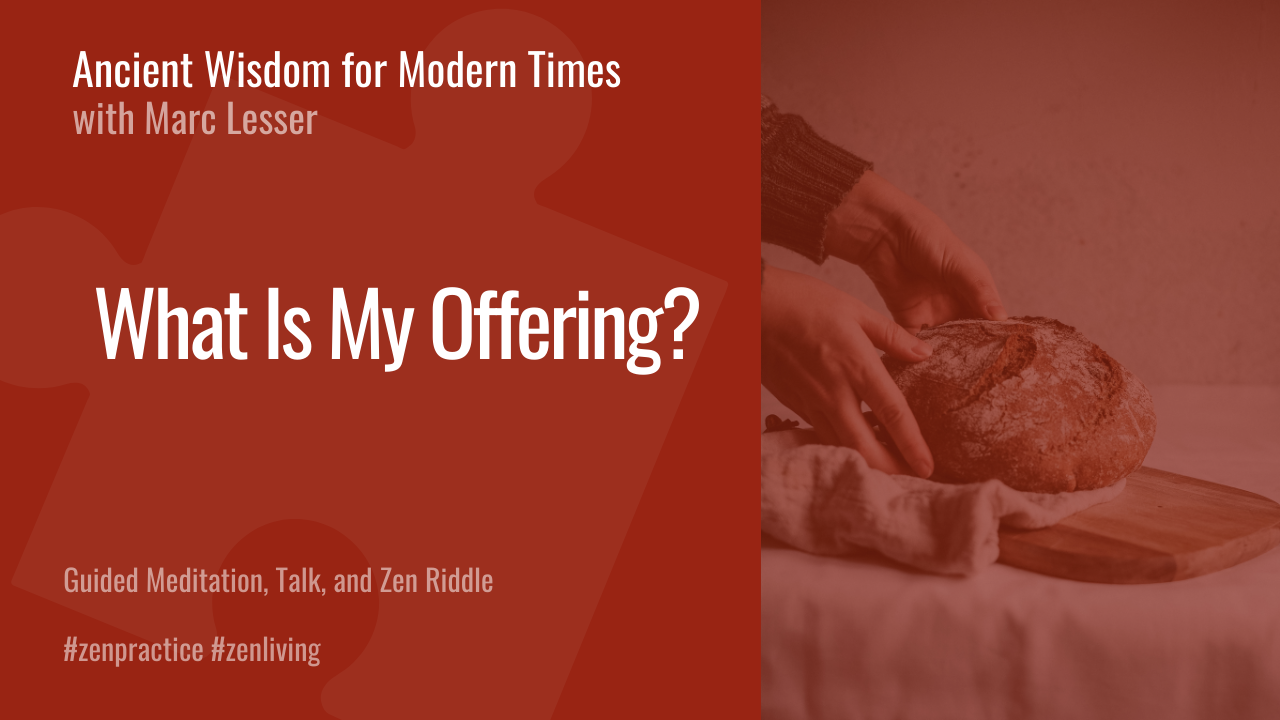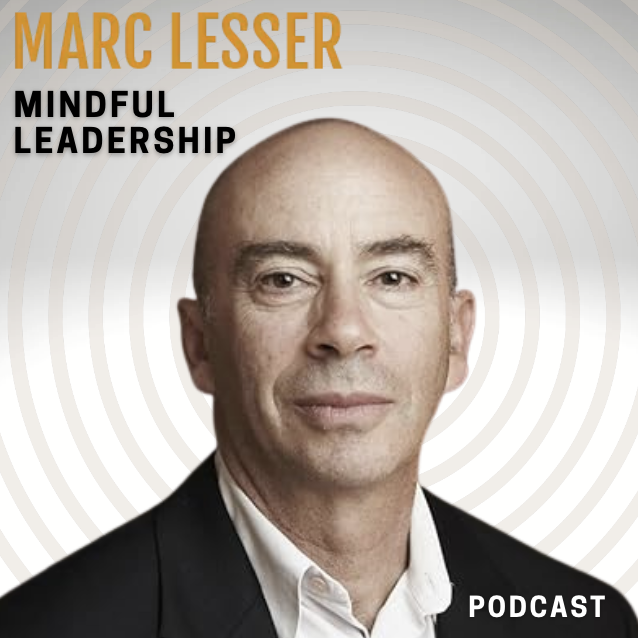What is my offering is today’s episode. We begin with a short guided meditation on warmhearted curiosity. Then Marc talks about the difference between helping, fixing, and serving – with an emphasis on practices for discovering your own offering.
Today’s Zen puzzler is using this phrase, What is my offering, as a Zen koan, or a support for going deeper into this realm of discovery.
EPISODE TRANSCRIPT
Marc Lesser: Welcome to Zen Bones. This is Marc Lesser. Zen Bones is a bi-weekly podcast featuring conversations with leading teachers and activists and an exploration of Zen teachings and practices. Please support our work by making a donation at marclesser.net/donate. [music]
What is my offering is today’s episode. We begin with a short guided meditation on warm-hearted curiosity. Then I talk about the difference between helping, fixing, and serving with an emphasis on the practice for discovering what your own offering is. Today, Zen Puzzler is using this phrase, what is my offering, as a Zen koan or a support for going deeper into this realm of discovery. What is my offering? I hope you enjoy today’s episode.
[music]
[pause 00:01:06]
Let’s begin with a few minutes of stopping and sitting together.
[pause 00:01:22]
[bell rings]
Yes, just noticing. Noticing the body and bringing attention to the sense of arriving and softening, relaxing, giving attention to the shoulders and back, softening the belly. Just noticing what it’s like to be here. This sacred practice of pausing, of stopping, and just being here. All of our to-do lists, they’ll be, they can wait. They don’t need us right now. Just bringing our full attention to being here, breathing, being alive, and nothing to accomplish. No sense of judgment or no need to make judgments or evaluations. Just letting that all go and being here, letting go of any ideas of certainty or uncertainty.
[pause 00:03:41]
Keeping it simple, bringing attention to the breath. Breathing in and breathing out. Breathing in, I know that I’m breathing in. Breathing out, I know that I’m breathing out, and dropping in, noticing what your approach is, how you’re feeling, what your mood is. Noticing. No need to try and change anything. No need to make anything different. Just noticing what is it like to be here, what is it like to be breathing, what is it like to be alive right now. I think bringing a sense of warm-hearted curiosity to this time so we are cultivating this beginner’s mind, curious mind, but not neutral, but with some sense of warm-heartedness or appreciation, of valuing this moment, this time together.
[pause 00:05:34]
Letting thoughts come and go, and I can always come back. I can always come back to the breath, to the body, to a warm-hearted curiosity.
[pause 00:06:07]
Nothing hidden. This is one of my favorite dialogues, and this is from Dōgen, 13th century, where he asks someone, what is practice? What is it like to be a full, flourishing human? This teacher of his, who’s a head cook of a monastery, says, nothing in the universe is hidden. Nothing is hidden. Opening. I’m going to ring a bell and make a shift, but you, of course, are welcome to keep sitting.
[pause 00:07:21]
[bell rings]
[music]
I’m going to talk today about the difference between helping, fixing, and serving. I want to begin with a short story about a time when I was called in to help facilitate a two-day retreat of business leaders who were, these were CEOs of a variety of for-profit and non-profit companies, and they were there to do a strategy meeting. There was a board meeting, and I was called in to do like a couple-hour session right in the middle of this two-day retreat.
As I entered the room, someone from the retreat came out, and one of the CEOs came out to greet me and said, this retreat is not going well. Welcome, but people are stressed and frustrated. That was quite the beginning. Now, I walked in and I could feel the tension in the room. They’re about 16, these CEOs, men and women. I immediately said, let’s do some sitting practice. Of course, I noticed several women came right to the front to sit. Other people in the middle decided to join. In the back of the room were maybe three men, I think, who were scowling and arms like, why are we doing this?
I led a short meditation practice for just a few minutes, emphasizing curiosity and warmheartedness. Then I suggested that we get into small groups, and I got them into, I think, four groups of four. My instructions were that each person should do a monologue where people wouldn’t
ask them questions or interrupt them. The suggested topic for each person to talk, to address for maybe like five minutes was, why are you here on the planet? What is your offering? Why are you here? What is your offering? How’s it going? The third question, what changes do you need to make based on how you answered the first two questions? I was really moved and a little bit relieved and surprised how much these leaders entered these questions. I could see the level of concentration and even some tears as people were engaging in this question, especially, right? Why are you here? Why are you here and what is your offering? That’s really, I think, the essential way to access and cut through this distinction between helping and fixing and serving and to see how from one perspective we are all here to serve. Ultimately, we are here to serve.
Sometimes, of course, helping and fixing can be needed and useful. What I want to really talk about here is the practice, the practice of serving. One thing to be careful of, when our life’s work is about service and activism, it’s often people burn out, feel a good deal of anxiety, never feeling like they’re doing enough. There’s a beautiful quote by Rachel Naomi Remen, who’s the author of The New York Times bestseller, Kitchen Table Wisdom.
She says, helping, fixing, and serving are three different ways of seeing life. When you help, you see life as weak. When you fix, you see it as broken. When you serve, you see life as whole. I really appreciate this distinction. The language that we use is powerful, and there can be really strong unconscious habit energy around helping and fixing. Helping and fixing sends a message that something is lacking or missing. Often, in how we see deeply, unconsciously almost see ourselves and others or the world. These words about helping and fixing create a sense of distance and separation.
On the other hand, serving, serving adds richness, connection, and a dimension to how we show up by including more curiosity, more acceptance, more warmheartedness and openness. Thinking of our work and our life as service is huge, is important. Whatever we’re doing, even often in so much of our work lives involves some form of sales or selling. Instead, I think there’s something about reframing sales and selling as offering. Again, stepping back and looking at whatever we’re doing, all work in some way is serving, is serving people, serving through products or services.
How do your work and what you do? Are you helping, fixing or serving? How do each of these labels feel or influence your approach? Whilst while offering our work as a service, we can feel really good at times. Sometimes it feels easy. Sometimes it feels like we are really making a difference. We seem to be wired for looking at what can go wrong. There’s no shortage of what can go wrong. There’s no shortage of not doing enough, and to be careful, even in this realm of serving to be careful about the negativity bias.
A good dose of optimism as well as hope can be useful. I’m not talking about the rose colored glasses optimism, but rather the sense of leaning into, imagining, visualizing what’s possible. How can we through our service make a positive change? I often come back, this is one of my favorite quotes that I come back to, I know over and over again is the Wendell Berry, be joyful though you’ve considered all the facts. Be joyful though you’ve considered all the facts.
There’s so many facts in our lives about what’s working and what’s not working and how all of our views and opinions, but there’s something about just the joy of being alive, knowing that one day we will lose everything and yet, and yet not turning away from what is painful, difficult, challenging. To be able to write in the midst of all of the challenges, come back to serving.
What is it, what are some of the practices that can support living a life of service? I think, again, my own experience and bias is meditation and mindfulness practice. I can’t, I can hardly imagine not having a regular meditation practice, not having a regular mindfulness practice. Just having this daily, regular time of, in a way, it’s feeling like I’m radically serving and being served just by stopping and feeling my own sense of completion and wholeness.
Then it’s also, I think, really important in living a life of service to find lots of support, to regularly connect with good friends. I think it’s useful to have a therapist, a coach, a body worker when we’re running and running a business or leading people. We’re so much involved in influencing that it helps to have ongoing support. I now have two different people that I do regular co-coaching with. I also so appreciate my Zen teachers, my therapist, regular study, regular study and exposure to engaging with, especially good, deep spiritual books.
I’m once again reading and studying Zen Mind, Beginner’s Mind. I’m also really appreciating beginning to study another book that is less known by Shinryu Suzuki called Branching Streams Flow in the Darkness. It’s some talks that he gave at Tassajara about a Zen poem called the Sandokai, The Harmony of Difference and Equality. Again, I think coming back to this question, what is your offering? What is your offering and what practices and support do you need to be able to come back, come back to this simple, deep, profound question?
One of the things I’ve been doing is more and more is listening to music as a way of supporting myself, my practice and I was recently introduced to a song by Adrianne Lenker called Steamboat and has really beautiful lyrics. As she says, well, I’m a stranger. I’m only a walker. I guess I’m human, but sometimes I feel like I’m only a ghost.
Like I’m only a wall. You come around, honey, I’ll probably just follow you home. Because it’s all that I know how to do. I was born by a body, and I’ll die by one too, and places are going if they ain’t got you. Oh, I wish I was better at being alone. Still, every night, I call you by phone., I wish I was more than my skin and my bones. Oh, I wish I was more than my skin and my bones. I love– Oh, I wish I was better at being alone. Still, every night, I call you by phone. Oh, I wish I was more than my skin and my bones. Oh, I wish I was more than my skin and my bones. Of course, we are. We are so much more than our skin and our bones. Wishing, wishing you some hope, a touch of optimism, and experiencing the richness of our lives, experiencing the richness of your life.
Coming back to this question, what is my offering? Why am I here on this planet? What is my offering? How am I doing? What changes might I make based on how I’m asking and responding and feeling about these questions? Coming back and asking and answering these great questions.
[music]
Welcome to The Zen Bones Puzzler, where I will regularly be presenting a story or a Zen koan or a poem. Something to contemplate, to think about. A story that has purpose. It’s about developing greater insight and reflection. Not so much for a solution, but as a way to support your practice. A meditation in daily life.
I’m pleased to be introducing today’s Zen Puzzler, where I take some traditional, non-traditional, modern Zen stories, or just lines from a reading or a poem, and look at how can we best utilize these stories? These stories are meant to cut through our usual, rather limited thinking, our mistaken beliefs, erroneous beliefs, the things that we hold on to, and help bring us to a more generous, awake place. A place where we can transform challenges and difficulties without ignoring them, but transform them into possibility.
I think as today’s Zen Puzzler, I want to continue with this topic. The line for today’s puzzler is, what is my offering? What is my offering? I was just on a call with an old friend who is dealing with cancer, and is really unsure how much time she has to live. Within that, she found her calling. She found a project that is just so bringing her alive, and it’s a legacy project which will be around for a long, long time. It’s a beautiful thing, this sense of finding your own calling.
This is something that I am working with myself right now, this question of what is my offering? In some way, I think it’s important to start from a place that there’s nothing lacking that if I were to die this day, then everything is perfect just as it is. I’ve done my best. I’ve given it my all. I think that’s a really important place to begin the work of engaging with this question of what is my offering? It’s not from a place of something missing, lacking. If I don’t do this, then no. It’s starting from a place of there’s nothing lacking, and is there something that wants to grow from that, without forcing it, without needing anything.
It’s interesting. This is beyond, it’s beyond helping and fixing. We’re not helping ourselves or fixing ourselves or others, but we’re opening to what’s possible. What is my offering? What might bloom? Often, so it’s interesting, in my compost pile in my backyard, there is lots of kale blooming. I think it’s quite beautiful, right? Often it’s out of the smelly, difficult compost. The compost of our lives is often where we can find the sense of what our offering is.
What can we do to influence the people around us? It’s not always about scale. It’s interesting, the tension that we often feel about depth and scale. Our offering can be helping one person at a time. It can be a great offering. Teachers and therapists and doctors, emergency workers, firefighters, so many ways to make an offering one person at a time. It’s one of the things that I love about writing, that I feel like my words and my books go out there and I have no idea who they can reach. Yet, there’s something powerful about the offering of our creativity, of our spirit, of our words.
Yes, so this is the Today’s Zen Puzzler, modern koan, which I think in a way, this is what this question, at least for many of us, is what brings us to practice and what sustains our practice is to keep coming back to this question, what is my offering? What is your offering? Thank you very much.
[music]
I hope you’ve appreciated today’s episode. To learn more about my work and my new book, Finding Clarity, you can visit marclesser.net. This podcast is offered freely and relies on the financial support from listeners like you. Please donate at marclesser.net/donate. Thank you very much.
[00:28:42] [END OF AUDIO]









